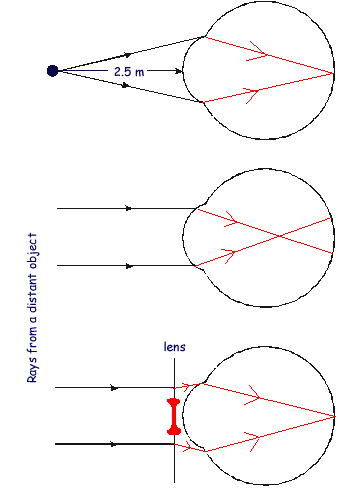Solutions: Medical Option - the EYE
Q5.
A defective eye has an unaided far point of 2.5 m and an unaided near point of 0.20 m. A correcting lens is used to produce an aided far point at infinity.
(a)
(i) Name the defect of vision affecting the eye.
Myopia 
(ii) State one possible cause of this defect of vision.
The eyeball is too long or the cornea is too curved/powerful. 
(2 marks)
(b) Complete the three ray diagrams on below for the defective eye.

1st diagram: rays focused on retina 
2nd diagram: rays focussed before retina 
3rd diagram: symbol for the concave (diverging) lens,  rays diverging from lens,
rays diverging from lens,  rays (after diverging) focused on retina
rays (after diverging) focused on retina 
(5 marks)
(c)
(i) Calculate the power of the correcting lens.
u = infinity so 1/u = 0
v = - 2.5 m
P = 1/v + 1/u
= - 1/2.5 + 0  = - 0.4 D
= - 0.4 D 
(ii) Calculate the aided near point when wearing the correcting lens.
v = - 0.20 m
P = 1/v + 1/u
- 0.40 = 1/u - 1/0.20 
1/u = 1/0.20 - 0.40 = 4.6
u = 0.22 m 
(4 marks)
(Total 11 marks)
